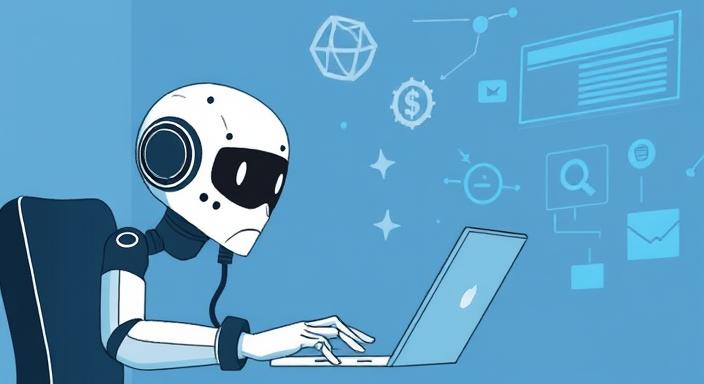The others are “Side Hustle,” an AI agent that pays 6% income for feature-length projects. The AI agent
Quick Summary: I tried the AI agent side hustle and made $_,___! This piece covers key points from my experience. The text looks at how developers make AI agents. It also the challenges non-techies face and the real earnings from this side hustle.
1. The Appeal of AI Agent Side Hustles
The source mentions a popular YouTube clip about the power of AI agents. It asks, “How to make $300 a day with AI agents? How to make $2,000 a week with AI agents, $50,000 AGI by using AI agents?” This big effort drove the author to test if this side hustle works for non-coders. the AI agent
2. Defining an AI agent
The author emphasizes that an AI agent is not a robot by stating, “an AI agent is not a robot.” Nope. Instead, this is an AI agent. It’s a standalone software that can think, plan, and act by itself.” This distinction is crucial for understanding the technical aspects of the paper.
3. Market Value of AI Agents
AI agents are in high demand, showing their value through prices. Companies are buying them, paying between $6,000 and $300,000 per agent. This generous pay is part of what draws people to this side hustle.
4. Accessibility for Non-CS Types: A Fundamental Question. The AI agent
A key point from the source is: “You can do this, even without any coding experience, by clicking buttons.” The writer calls himself a “non-developer” with “no coding experience.” He wants to challenge that idea. He wants to know if it’s good for “non-techie people” and what potential earnings might be. The AI agent

5. What to run on the software side: N8N and the open-source vs. cloud conundrum.
Researchers discovered that N8N is the most popular platform for generating agents hands-free. The author discovers two versions:
Free open-source model: You can download it on GitHub. Developers need to “find a way to” handle hosting, firewalls, and databases on their own.”
Cloud-based version: Monthly fee.
Non-technical writers struggle with hosting, firewalls, and databases for the free product. The paid cloud version, like the pro plan ChatGPT suggested, is a better choice.
6. Developing an AI Agent: The Early Hiccups
The authors first tried to build an agent that follows a YouTube tutorial. This tutorial explains how to create an agent that sends emails. Key steps and challenges included: The AI agent
Connecting to a Chatbot (OpenAI): The author picked OpenAI—check the “credentials.
Paid Credits for AI Usage: It’s “not free for your agent to use ChatGPT. Each use will cost paid credits.” But, the price increases as the models become fancier.
**API Keys Creation:** First, create an OpenAI developer account. Then, generate secret API keys. These keys link the agent to the user’s billing. The tutorial the author used didn’t mention this. So, he looked into “OpenAI support documents.
Billing and Initial Charges: The author needed to add a credit card and a least of $5 to an OpenAI API profile. A test interaction was 1 cent, W/O the promised “hundred free API credits” (which were never given).
Memory + Memory Retention: Agents have no built-in memory. This requires a “memory node” (i.e., a window buffer memory from the internal storage of an N8N). The number of conversations an agent can remember, like 5, 10, or 20, impacts resource use and costs.
Tooling up (Gmail): The first time I connect to an external service like Gmail, I need to “add credentials.” This is part of the service sign-on process.
Personalizing Agents:
Users can change the agents’ default “helpful assistant” role. For example, they can set the model to “speak like a pirate.” You can provide specific instructions to the agent, for example, on how to sign the emails.
This visual agent works, but it’s not what the author wanted. They said, “The learning curve to make these is definitely more than I thought.”
7. Client Acquisition: Beyond Paid Advertising
The third day is about client acquisition, often referred to as “the hard part.” Most tutorials suggest using paid ads, like Google or Facebook ads. However, the author recommends focusing on word-of-mouth and personal recommendations instead. Based on previous experience with an SEO agency, the author recommends:
Joining local coworking spaces at a low rate helps you connect with others. Working there at different times sparks natural conversations.
Networking: Conversations about jobs were common. Referrals came from the connections people had. After all, most people knew a friend or neighbor with helpful resources. the AI agent
Personal Contact Outreach: I planned to email everyone from the coworking spaces. I would reach out and ask if they knew anyone looking to buy an agent.
8. Truth of Client Projects: Tech Gaps
28 days later, the author had a prospect for “sales scoring lead agent.” This agent would:
Read customer emails and social media comments.
Identify messages indicating buy interest.
Give a “lead score” (1-100% likely to buy).
Direct high-scoring leads to sales. Send low-scoring ones to marketing for more nurturing and development.
But the author hit a wall:
No Advanced Tutorials:
A YouTube search for “sales lead scoring agent” showed only basic tutorials. Most focused on scoring leads from a simple web form. It also had some partial advanced tutorials. Many advanced tutorials were also behind paid “school classes” or memberships.
Technical Skill Required: Our author struggled to reimplement the advanced agent in N8N. They lacked a step-by-step guide and extensive technical expertise.

“I didn’t know what I should add. If I know which tool to add, you still need to choose the right parameters and settings. This ensures it meets your client’s goals.”
9. The Bottom Line in Our No-Code vs. Knowing Code Debate
The experiment showed that “YOU can build AI agents without code” in theory. But, for complex projects, some coding is still needed. “If you want to build agents for clients from scratch, you still need technical know-how.”
The author notes that this side hustle has a “reasonably steep learning curve for most people.” This explains why businesses pay well for agents. The ability to understand the details of these tools and how to set them up correctly.
10. Financial Outcome
Here’s how much the author made from the AI agent side hustle: $0. Yes, I made $0.” This result comes from the author not having a “technical brain.” Instead, they have a “more artistic, less technical brain.”
Conclusion
The source provides a genuine, firsthand account of the AI agent side hustle effort. While the high earning potential and “no-code” promise sound great, there’s a lot to learn. This can be tough for those without a technical background. To build custom, complex agents for clients, you need a solid grasp of bot creation basics. This game depends a lot on a player’s skill to learn and use special technical knowledge, even in a “no-code” area.


